US Smart Meter Market Size
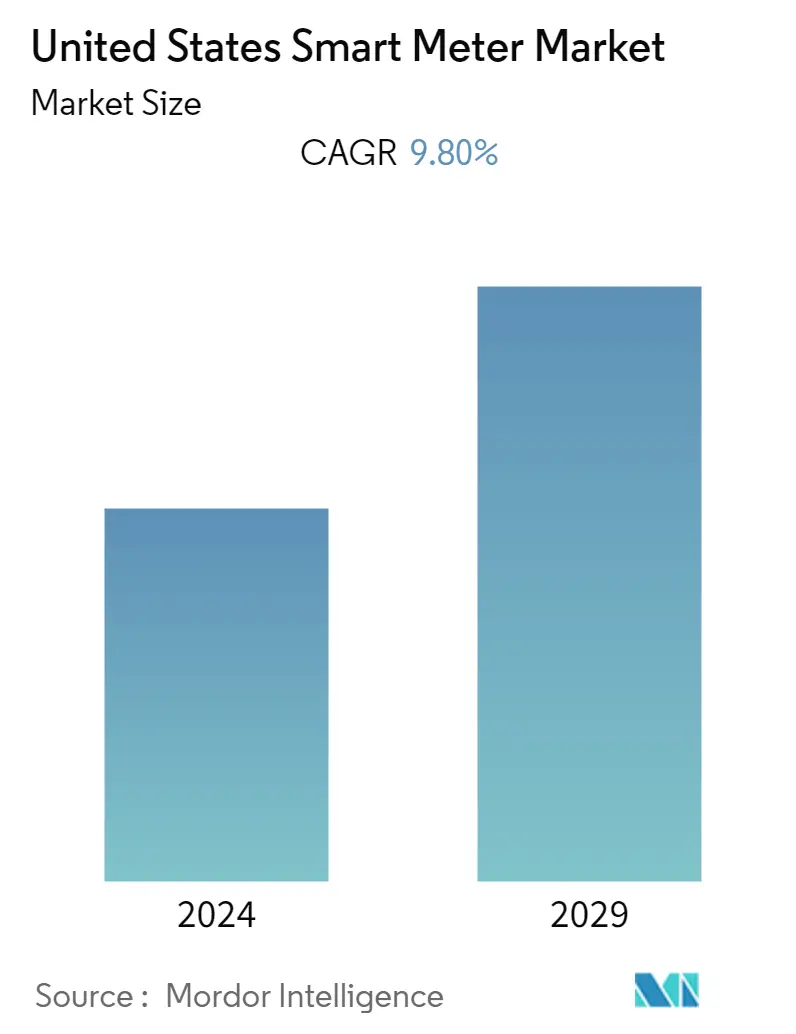
| Study Period | 2019 - 2029 |
| Base Year For Estimation | 2023 |
| Forecast Data Period | 2024 - 2029 |
| Historical Data Period | 2019 - 2022 |
| CAGR | 9.80 % |
| Market Concentration | Medium |
Major Players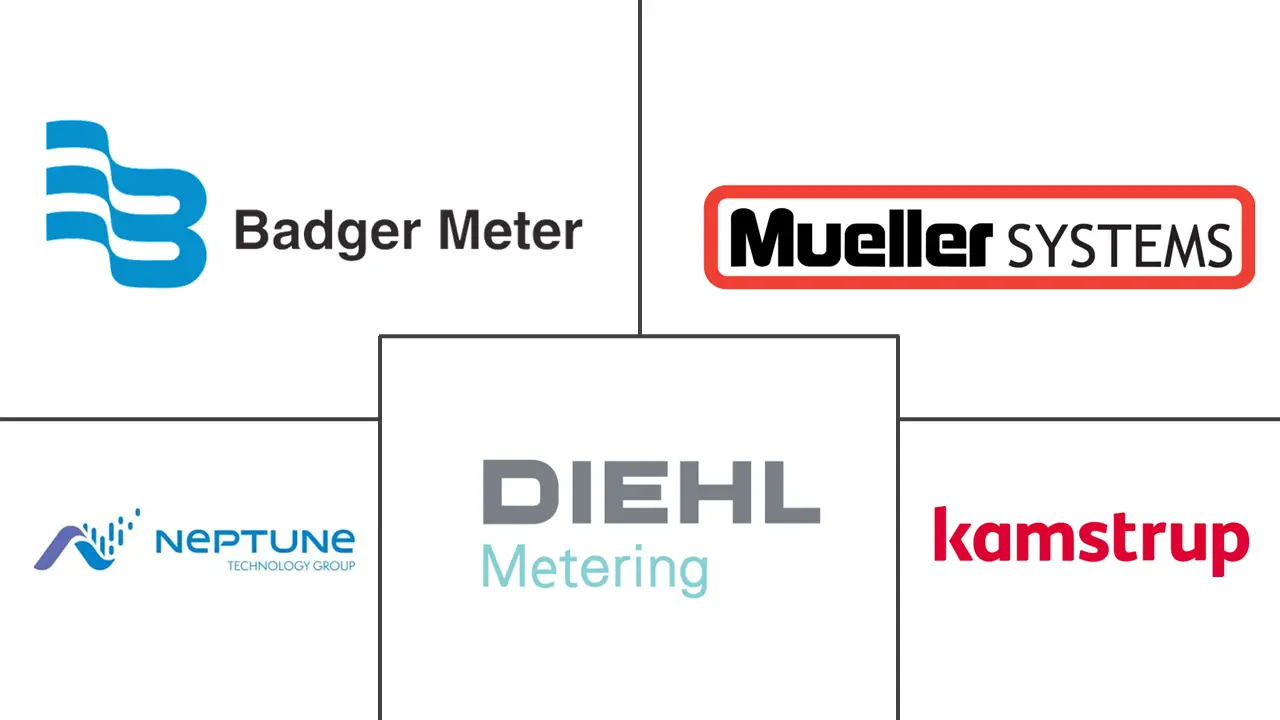
*Disclaimer: Major Players sorted in no particular order |
US Smart Meter Market Analysis
The United States smart meter market was expected to grow at a CAGR of 9.8% for the forecast period (2022-2027). Implementation of different government regulations mandating the installation of smart meters and increased investments in smart grid technology, coupled with growing consumer awareness about the benefits of installing smart meters, are the major factors fuelling the market growth.
- As utilities seek more efficient, reliable, and secure ways to manage energy generation, transmission, and distribution, the smart grid has emerged as an effective approach to aligning the supply of energy in a given market with demand while reducing waste. The smart meter is one of the most important devices used in the smart grid and has two-way communication capability between electric utilities and customers. In recent years, increasing investments in smart grid projects along with different government policies, particularly mandates and fiscal incentives, are among the key drivers of market adoption of smart meters in the United States.
- For instance, in September 2021, the U.S. Department of Agriculture announced that it would invest USD 464 million to build or improve renewable energy infrastructure and help rural communities, agricultural producers, and businesses lower energy costs in 48 states and Puerto Rico. The USDA financed USD 335 million of these investments through the Electric Loan Program, including USD 102 million for investments in smart grid technology.
- Further, consumer demand for smart and green services continues to grow and they are now seeking personalized services that enable them to optimize usage and reduce bills. Through smart meter data, utilities are able to help customers reduce energy costs, which is another factor driving the growth of the market.
- At the start of the Covid-19, the primary impact faced by many smart meter manufacturers was supply problems, owing to halted production. Moreover, owing to lockdown measures, demand for residential, commercial, and industrial use of smart meters also decreased. However, with the ease of the pandemic-related lockdowns, manufacturing and supply of smart meters are returning to normal levels, with many manufacturers starting to witness a recovery in sales.
- However, the initial investment involved in setting up smart meter infrastructure is usually much higher as compared to traditional meters, and it also takes a longer time to achieve high returns on investments. The requirement for huge capital poses a significant challenge to both energy consumers and utility providers, which acts as a market restraint.
US Smart Meter Market Trends
This section covers the major market trends shaping the US Smart Meter Market according to our research experts:
Smart Gas Meter Segment to Grow Significantly
- A smart gas meter utilizes ultrasonic or electromagnetic technologies to measure gas flow, while using wireless communication to connect to local or wide area networks, which allows infrastructure maintenance, remote location monitoring, and automatic billing.
- The device also has leakage and shock detection systems that can significantly increase safety by detecting emergency situations and enabling the immediate and remote cutting of the gas flow in case of seismic activity or gas leakage. A smart gas meter relies on low-voltage battery power to extend operational life and avoid ignition hazards.
- Smart gas metering allows gas companies to efficiently manage their operations, including energy production, distribution, and deliveries, while reducing costs and optimizing resource allocation. They can remotely monitor customers' consumption and switch gas on and off to avoid costly onsite visits.
- In August 2021, US utility companies Louisville Gas and Electric Company (LG&E) and Kentucky Utilities Company (KU) signed a five-year contract with Landis+Gyr for the provision of smart meters and smart grid infrastructure and technologies. The agreement includes the supply of 930,000 smart electricity meters, 300,000 gas modules and an IoT network for connectivity.
- Favorable government initiatives towards the installation of smart meters in the US are the primary factors driving the market growth. Further, rising internet penetration along with increased adoption of high-speed network technologies and smartphones are also propelling the market, as the synching of smart gas meters with smartphones can easily be used to perform remote monitoring of the gas meters with smartphone apps.
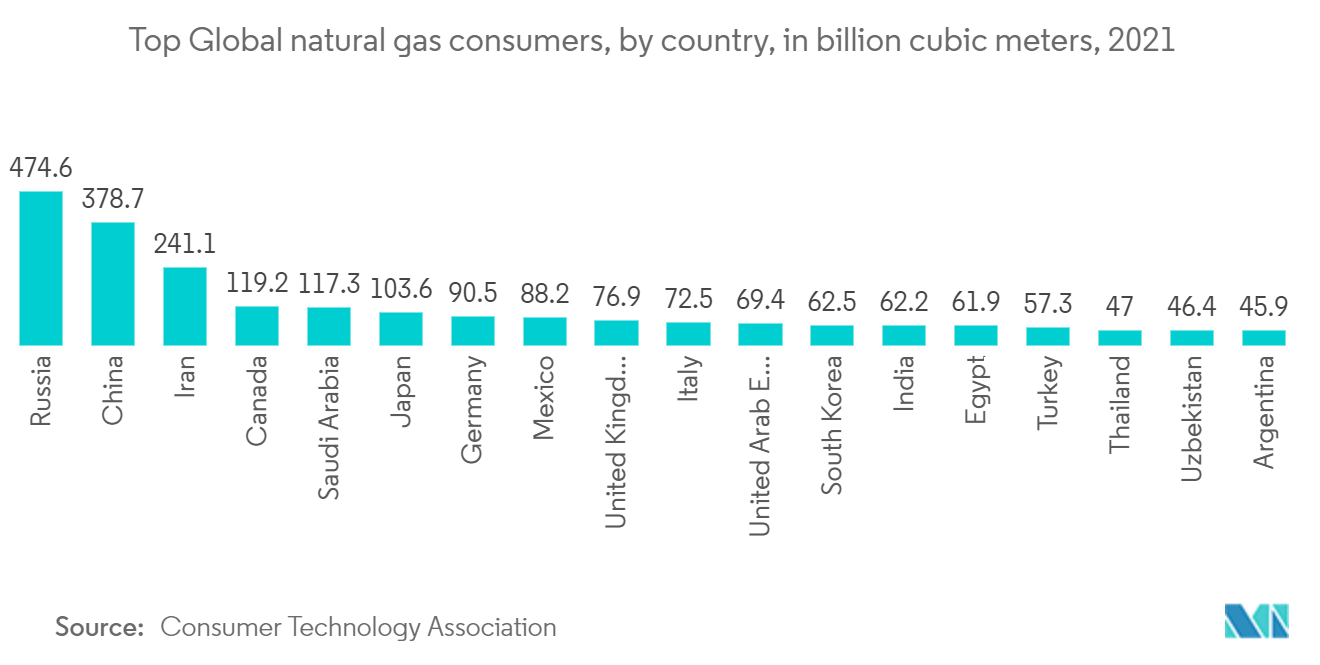
Residential Sector to Hold a Major Market Share
- The most demand for smart meters in the United States is for residential meters, as more consumers are using these meters to monitor electricity usage at their homes more accurately. The bulk of residential smart meters is procured and installed by utilities.
- In the residential sector, the demand for smart meters is primarily driven by the rising power consumption due to increased use of home appliances like air conditioners, televisions, refrigerators, lighting, ceiling fans, cloth washers, personal computers, and HVAC (Heating, ventilation, and air conditioning) equipment in residential buildings. Utilities are looking for ways to address the dynamic demand for power from the operations of this equipment and are thus investing in smart meters to enhance grid resiliency and operations.
- Smart meters also help in integrating distributed energy resources (DERs), energy storage technologies, and EV charging facilities in the residential sector.
- Further, the increasing government initiatives to boost the adoption of smart meters in households to reinforce accurate meter readings and provide better transparency in energy consumption for both consumers and utility companies are also propelling the market growth.
- As per the United States Department of Energy, over 100 million advanced smart electric meters have already been installed throughout the country, with residential installations representing 88% of the total. With continued efforts to use modern technology to improve the effectiveness of the electric grid, consumers are expected to have more opportunities to manage electricity consumption efficiently and reap significant savings in the long run through the installation of smart meters.
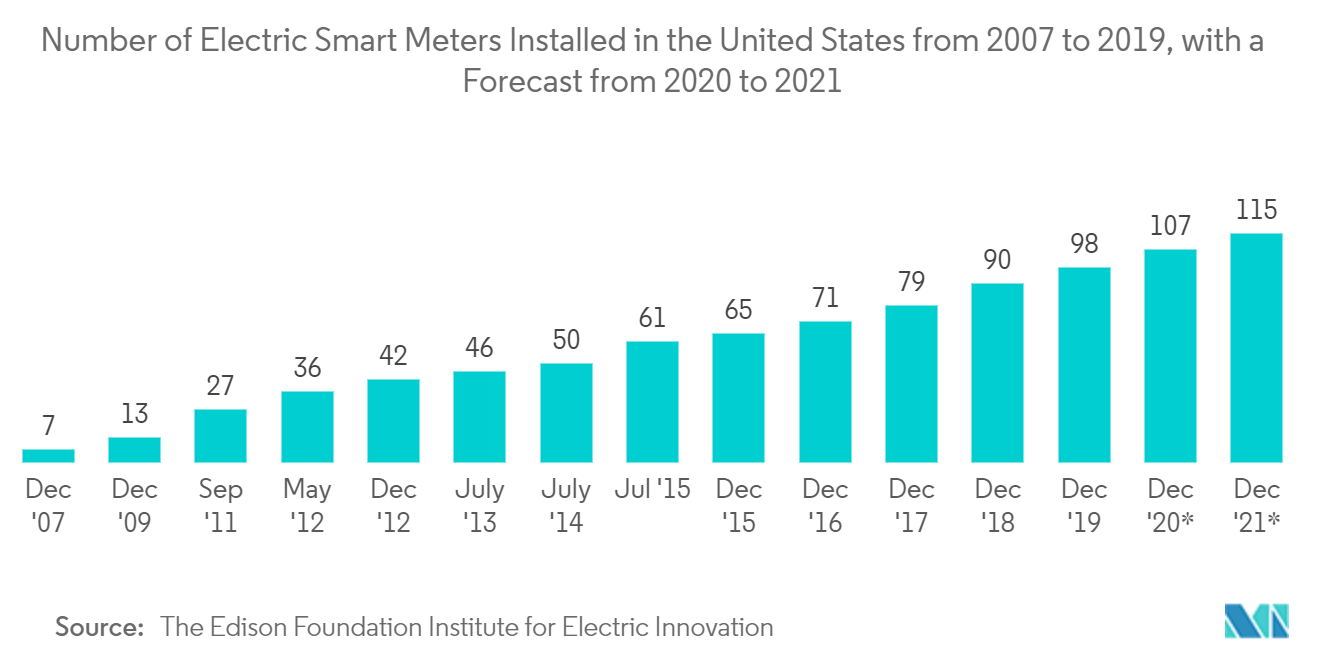
US Smart Meter Industry Overview
The United States smart meter market is moderately competitive and consists of some influential players. These businesses are leveraging strategic collaborative actions to improve their market percentage and enhance their profitability.
- September 2021 - Kamstrup introduced a new smart electricity meter, OMNIA, to enhance its offering within the advanced metering market. The new product is based on cellular IoT, a communications standard that continues to see widespread adoption within the utility industry, as energy companies and technology vendors seek to develop a resilient network for fast and secure data telemetry.
- May 2022 - Neptune Technology Group selected US-based enterprise billing and monetization solution provider, BillingPlatform, for its subscription-based billing capabilities to be used with Neptune's Smart Water solutions, which include measurement tools like smart meters, networks, software, and services designed for the critical work of water.
US Smart Meter Market Leaders
-
Badger Meter Inc.
-
Mueller Systems LLC
-
Diehl Metering US
-
Kamstrup
-
Neptune Technology Group Inc.
*Disclaimer: Major Players sorted in no particular order
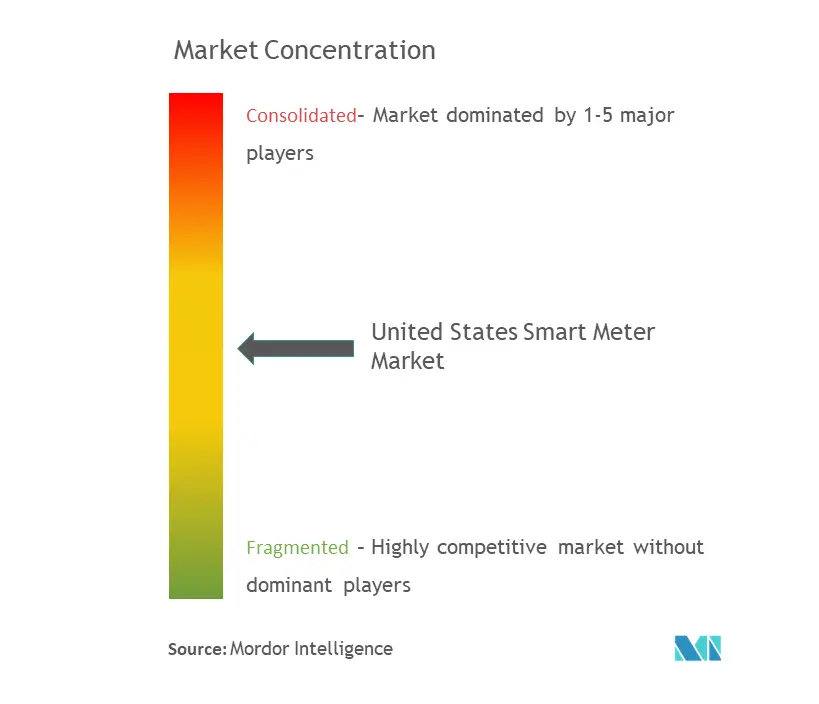
US Smart Meter Market News
- January 2021 - Badger Meter, Inc. announced the acquisition of US-based Analytical Technology, Inc. (ATi), a privately held provider of water quality monitoring systems, for USD 44 million. ATi specializes in the design, manufacture and distribution of water quality instruments based on electrochemical and optical sensors.
- March 2022 - Mueller Systems was selected by Pace Water System in Santa Rosa County, Florida, to deploy a pilot program for their water meter system which includes new features that allow customers to control their meter from a mobile phone.
US Smart Meter Market Report - Table of Contents
1. INTRODUCTION
- 1.1 Study Assumptions and Market Definition
- 1.2 Scope of the Study
2. RESEARCH METHODOLOGY
3. EXECUTIVE SUMMARY
4. MARKET INSIGHTS
- 4.1 Market Overview
-
4.2 Industry Attractiveness-Porter's Five Force Analysis
- 4.2.1 Bargaining Power of Suppliers
- 4.2.2 Bargaining Power of Consumers
- 4.2.3 Threat of New Entrants
- 4.2.4 Intensity of Competitive Rivalry
- 4.2.5 Threat of Substitutes
- 4.3 Industry Value Chain Analysis
- 4.4 Impact of COVID-19 Outbreak on the Industry
5. UNITED STATES SMART METERS MARKET - INDUSTRY POLICIES AND REGULATIONS
6. UNITED STATES SMART METERS AND SMART GRID INITIATIVES
7. MARKET DYNAMICS
-
7.1 Market Drivers
- 7.1.1 Higher Consumer Awareness and Government Regulations Mandating the Installation of Smart Meters
- 7.1.2 Increased Investments in Smart Grid Projects
- 7.1.3 Investments in Smart City Developments
-
7.2 Market Challenges
- 7.2.1 Higher Costs, Security Concerns and Integration Difficulties with the Installation of Smart Meters
- 7.3 AMI integration with customer information system, distribution management system, billing systems, etc.
8. MARKET SEGMENTATION
-
8.1 By Type
- 8.1.1 Smart Gas Meters
- 8.1.2 Smart Water Meters
- 8.1.3 Smart Electricity Meters
-
8.2 By End-User
- 8.2.1 Commercial
- 8.2.2 Industrial
- 8.2.3 Residential
9. STUDY ON SMART METERS SOFTWARE SYSTEM
10. COMPETITIVE LANDSCAPE
-
10.1 Company Profiles
- 10.1.1 Badger Meter Inc.
- 10.1.2 Mueller Systems LLC
- 10.1.3 Diehl Metering US
- 10.1.4 Kamstrup
- 10.1.5 Neptune Technology Group Inc.
- 10.1.6 General Electric Co.
- 10.1.7 Itron Inc.
- 10.1.8 Sensus USA Inc. (Xylem Inc.)
- 10.1.9 Elster American Meter (Honeywell International Inc.)
- *List Not Exhaustive
11. VENDOR MARKET SHARE ANALYSIS
12. INVESTMENT ANALYSIS
13. FUTURE OUTLOOK OF THE MARKET
** Subject To AvailablityUS Smart Meter Industry Segmentation
A smart meter is a digital device that utilizes two-way communication to connect utilities and consumers and support demand response and distributed generation. The device obtains information from the end users' load devices and measures the energy consumption of the consumers, and then provides added information to the utility company. In addition to reporting the energy usage of the consumer, the smart meters can also inform the utility immediately if there is a power outage in the consumer's area.
| By Type | Smart Gas Meters |
| Smart Water Meters | |
| Smart Electricity Meters | |
| By End-User | Commercial |
| Industrial | |
| Residential |
US Smart Meter Market Research FAQs
What is the current United States Smart Meter Market size?
The United States Smart Meter Market is projected to register a CAGR of 9.80% during the forecast period (2024-2029)
Who are the key players in United States Smart Meter Market?
Badger Meter Inc., Mueller Systems LLC, Diehl Metering US, Kamstrup and Neptune Technology Group Inc. are the major companies operating in the United States Smart Meter Market.
What years does this United States Smart Meter Market cover?
The report covers the United States Smart Meter Market historical market size for years: 2019, 2020, 2021, 2022 and 2023. The report also forecasts the United States Smart Meter Market size for years: 2024, 2025, 2026, 2027, 2028 and 2029.
Anesthesia Gas Industry Report
The report on Smart Meter Manufacturers in the US provides a comprehensive industry analysis, focusing on market segmentation by type and end-user. The market forecast includes smart gas meters, smart water meters, and smart electricity meters, catering to commercial, industrial, and residential sectors. This industry analysis reveals significant market growth, with industry statistics and market data highlighting key trends and market leaders. The market overview offers insights into the industry size and market value, supported by industry reports and market research.
The report example includes a detailed market review and market predictions, emphasizing the importance of market segmentation and market outlook. Industry trends and industry outlook are discussed, providing a clear understanding of the industry's direction. The market forecast and market growth are crucial components of the industry research, offering valuable insights into future developments.
Industry information and industry sales are also covered, with a focus on industry size and market value. The report pdf serves as a valuable resource for research companies, providing in-depth industry statistics and industry trends. The market outlook and market overview are essential for understanding the market dynamics, while the market review and market predictions offer a glimpse into future opportunities.
In summary, this report is a vital tool for anyone looking to gain a comprehensive understanding of the Smart Meter Manufacturers market in the US. It includes industry reports, market data, and a report pdf, making it a valuable resource for industry professionals and research companies alike.



